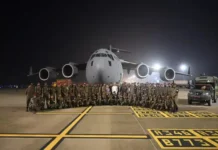From what has appeared in the public domain, India is dealing with China, a neighbour who has turned progressively hostile in the post-Doklam months, with a matching firmness on the LAC while keeping the doors open for bringing about de-escalation through border talks. An accelerated diplomatic effort designed to keep the international community informed of the ‘expansionist’ profile of China facing an advocate of global peace like India, is yielding results. Also, a comprehensive strategy of checkmating China’s plans in Indo-Pacific, in India’s neighbourhood and in the area of influence of China’s all-weather friend, Pakistan, in the so-called ‘Muslim world’, is on the anvil.
India has maintained the pace of strengthening of its defence forces, particularly in the sphere of mountain warfare, and taken care of the new situation created by the Sino-Pak axis that was militarily and operationally pursuing its hostile plans against this country. The twin threats from Pakistan and China now seem to represent a lasting security challenge for India and it is as well that we do not allow any wishful thinking on the intentions of these adversaries to affect our strategic planning.
India is taking timely initiatives to counter balance China geo-politically, firmly deal with the new offensive of Sino-Pak combine and reach out to Afghanistan to keep this crucially located neighbour within a friendly orbit. Foreign Minister S. Jaishankar’s participation in the meeting of Quad at Tokyo on October 6 announced India’s full-fledged role as a member of this forum of four major Indo-Pacific democracies including US, Japan and Australia. In the backdrop of India’s border dispute with China and the latter’s aggressive behaviour in the Indo-Pacific and South China Sea, Jaishankar’s emphasis on ‘rule-based international order, territorial integrity and peaceful resolution of disputes’ at this meeting would send a message to China that India was willing to take on China in theatres outside of the India-China land border.
The four nations agreed to step up coordination in creating a free and open Indo-Pacific. Mike Pompeo, US Secretary of State taking a hard line against China asked the Asian allies to unite against Beijing’s ‘exploitation, corruption and coercion in the region’. He denounced China’s actions in Hong Kong, Himalayas and the Taiwan Strait. In this second meeting after 2017, Quad has evidently acquired teeth against a growing belligerence of China in the Indo-Pacific region. Jaishankar has stated upfront that India’s objective was to advance the security and economic interests of all countries having legitimate stakes in the region. Quad will check ill-conceived moves of China in the Indian Ocean also — India should anyhow make its Naval presence felt here to deter any such Chinese designs.
As indicated earlier, the most serious threat to India’s national security today is from the Sino-Pak alliance that is now operating at a new level of collusion in so far as its hostile plans against India are concerned. This is visible in Jammu and Kashmir where Pakistan has stepped up infiltration of terrorists into the state from across the LOC as well as the international border in Jammu — evidently with instigation from China — judging from the fact that Chinese firearms have surreptitiously been dropped in the Valley using drones and hexacopters made available to Pak ISI by China. India’s military build-up in Ladakh, which was necessitated by the aggression shown by PLA since the Galwan incident of June 15, has predictably seen a further deepening of the Sino-Pak military and operational coordination pitched against India. India has done well to tell Pakistan that the only ‘unfinished agenda’ on Kashmir was the restoration of POK to India and also remind China of its illegal occupation of Aksai Chin. India’s potential for hitting the ‘illicit’ infrastructure of CPEC erected by China on POK territory should be put out as a part of India’s right to re-take that land by extending counter-terror measures in Kashmir beyond the LOC. China cannot have any advantage over India in mountain warfare — we must, therefore, steadily improve our capabilities to take on the two adversaries together. In sectors other than Ladakh, India can stretch the PLA at points of its choosing.
It is significant that the Pak army — an old practitioner of ‘proxy war’ against India — has found it easy to be in cahoots with the PLA that was trained in ‘deception’ — the war strategy of Sun Tzu favoured by President Xi Jinping. A new challenge for India’s security set-up is to comprehensively counter the joint covert offensive of China and Pakistan in Kashmir and elsewhere — in spheres ranging from cyber attacks to subversion for creating internal unrest and acts of sabotage against this country’s military and economic assets. Coordination for all intelligence production, collation and analysis has acquired added importance. Safeguarding economic security is now integral to national security and India has to watch out against Sino-Pak mischief of hurting India economically. Counter-intelligence operations have to be taken closer to the ground so that the invisible forces and agents provocateurs behind politically instigated protests, demonstrations and agitational violence at local levels can be exposed.
India is vulnerable to sectarian, communal and ethnic divides in the mainland as well in the peripheries which gives our adversaries a handle to fish in our troubled waters. Also, deviants, loiterers and whisper mongers should be under the umbrella of security watch. It should be disseminated through various means that since ‘security is for all’ there should be an awareness of the ‘duty of all’ citizens to contribute to it by being alert about the environ around.
It is not a day too soon that India has activated its diplomatic effort to see that the current Intra Afghan Negotiations move towards ensuring a democratic future for Afghanistan, rightly described as ‘the geographical pivot of history’. A country that was central to the Great Game of the Cold War era has once again become a fulcrum of Chinese attempts in collusion with Pakistan to dominate this region in a situation of rising US-China contestation at the global level. The current dispensation of Afghanistan, as also the US-led West, wanted India to be amongst the regional neighbours supporting the negotiations — overriding the Pak objections to India’s presence — and India appropriately responded to the invite of the host country Qatar by deputing its External Affairs Minister to address the opening session of the negotiations at Doha on September 10. There was also an assurance from Zigmay Khalizad, the chief US interlocutor, that the talks will be ‘Afghan-owned Afghan-led and Afghan-controlled’ and will work for an ‘inclusive’ solution notwithstanding the participation of Taliban in any future set-up. Abdullah Abdullah, head of the High Council for National Reconciliation formed by Afghanistan had visited India on the eve of the Doha meet.
It was from a position of strength that S. Jaishankar told the gathering where the US Secretary of State Mike Pompeo, representatives of NATO, Russia, Iran, China and Pakistan besides the Central Asian neighbours of Afghanistan, were present, that the peace process must respect the sovereignty and territorial integrity of Afghanistan, must promote human rights and democracy, ensure the interests of minorities, women and vulnerable sections and effectively address violence across the country. It was thus made clear that India will accept only a democratic and inclusive dispensation in Afghanistan and not a fundamentalist regime that the Taliban-Al Qaeda had established in 1996 on the strength of support from Pakistan. India has to checkmate the game Sino-Pak axis was playing for acquiring a say in Afghanistan with the help of Taliban. Apart from the US, Russia and Iran are the key countries India must keep on its side for pressing for an inclusive and democratic character of a future Islamic republic of Afghanistan — India has rightly befriended both Ashraf Ghani and Abdullah Abdullah in this regard.
As a collaborator of China in the latter’s anti-India activities, Pakistan needs to be given a befitting reply by way of a stronger action against terror launching pads in POK. A new strategic challenge for India is to counter the sources of support that Pakistan has in the Islamic world in its conflict with India — because of the faith-based approach Pakistan invoked in its foreign and security policy by projecting Kashmir as a Muslim issue and raising questions on India’s domestic scene in regard to the position of Muslim minority here. Countries like Turkey and Malaysia should be confronted for bringing in religion into politics, democratic nations should be mobilised for supporting the robust democracy that India was in comparison to Islamic dispensation of Pakistan that instigated faith-based militancy and the OIC should be persuaded to take a stand that the call of Jehad should not be used for solving political issues in today’s world. At the same time, India must continue working for strong economic and strategic relations with those Muslim and Arab countries who recognised the importance of democratic character of Indian republic. Both at home and abroad, India should continue to highlight the equality of rights that was available to all citizens here regardless of distinction of caste, creed and race. We have to be upfront about exposing the Sino-Pak nexus as the new combine of a Communist dictatorship and an Army-controlled regime promoting ‘Islamic terror’, that posed a threat to the entire democratic world.
(The writer is a former Director Intelligence Bureau)







